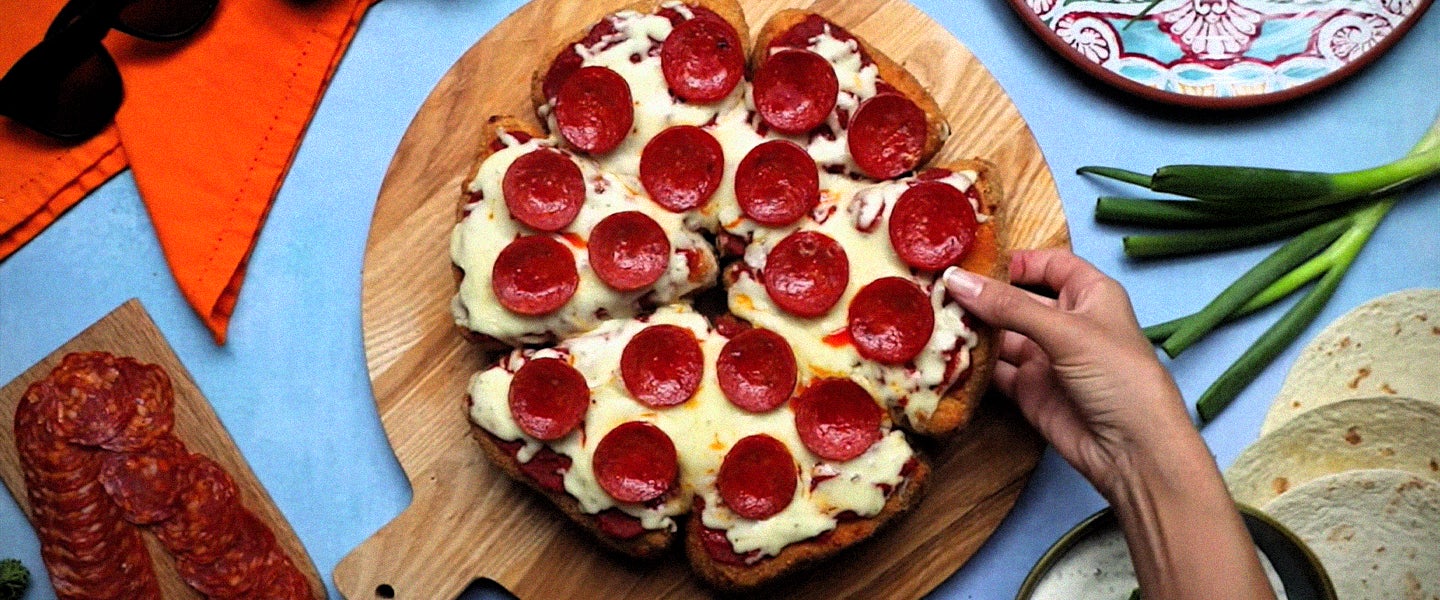Last week, when the now infamous chicken-stuffed deep-fried pizzadilla went viral, the online world shared the video with slight horror over its “needless excess.” The recipe, created by the YouTube channel Twisted Foods, draws on a format pioneered by BuzzFeed’s Tasty, but takes it to a whole new extreme by using more than 30 ingredients, three different cooking methods and an endless amount of cheese.
I needed to learn the name of this monstrosity and even it’s excessive – “deep fried bbq chicken stuffed pizzadilla.” ?
— Lori (@Kalottie1009) August 25, 2019
Such gluttony, however, definitely mesmerized Ish Tehara. “It’s not that it’s appetizing,” the 21-year-old from London explains. “I’d never actually make that in my life. The appeal is just how much food is in there, and how complicated it is.”
Tehara frequently watches YouTube channels like Epic Meal Time — one of the earliest food channels on the platform — in which a group of guys make large, bizarre concoctions out of fast food (e.g., the 6-Foot Big Mac, The Fast Food Stadium and the Giant Pizza Pocket). He found other channels via Epic Meal Time, like the amateur chef Barry Lewis, who is famous for making giant versions of British snacks, and Hellthy Junk Food, which is essentially recipes for American fast-food favorites.
All of them allow him to experience fast food without actually eating it — a particularly important distinction as he’s recovering from a binge-eating disorder. “It feels like a high,” he says. “So while it’s not the same thing, getting to experience it secondhand is helpful to me.” Saddled with a taxing job, difficult family situation and sudden breakup, Tehara, like many men, found himself turning to food as a way to manage his stress and anxiety. “After work, I wouldn’t have eaten all day so I’d go to a McDonald’s, eat three large Big Mac meals, and then go down the street to a KFC for more sandwiches and fries,” he says.
Things only got worse from there, and he found himself hoarding food in his bedroom. At the end of last year, when a friend at work was concerned by both Tehara’s sudden weight gain and his downbeat mood, he was recommended to a counselor, and later, a therapist who specializes in male eating disorders.
Binge eating is by far the most prevalent form of disordered eating among men. According to a 2012 study in The International Journal of Eating Disorders, nearly 10 percent of men between the ages of 18 and 65 suffer from it, while the Binge Eating Disorder Association estimates that 40 percent of the estimated 10 million Americans who binge eat are men. “It’s likely that the number of men who suffer from binge-eating disorders is higher,” says Michele Kabas, a psychotherapist who specializes in eating disorders among men. “In society, there’s an assumption that eating disorders are really just anorexia and bulimia, and that it’s about people who deliberately starve themselves for long periods of time. But in reality, eating disorders are way more complicated, and more men suffer from them than you’d expect.”
They’re also more public than ever before. That is, the growth of food channels on platforms like YouTube has meant that binge eating has become its own form of online content. “Mukbang,” a type of video that originates in South Korea and usually features a YouTuber consuming thousands of calories worth of food (typically dozens of bowls of ramen noodles), is a perfect example. In the West, mukbang videos involve buckets of fried chicken, spicy Indian food and McDonald’s hash browns. In fact, one of the most popular genres of videos in the fitness YouTube space isn’t a workout routine or diet plan — it’s of muscular bodybuilders documenting their 10,000-calorie mukbang.
Not surprisingly, mukbang videos have been criticized for normalizing binge-eating disorders. But for some people, engaging with this kind of content can actually help, at least in the short term. Writing on Her Campus, Jillian Holness talks about the “high” she feels by “seeing strangers gorge themselves of fatty, greasy food” online. In regard to one notorious mukbang video entitled “Taco Bell Haul,” which has garnered more than 2 million views since it was uploaded in 2014 by YouTuber Trisha Paytas, Holness writes:
“Paytas looks into the camera as she introduces each item she bought, before taking a bite and moaning extravagantly. It was like my taste buds were in sync with hers. I could taste the chicken quesadillas she bit into, the tortilla chips she dipped in warm nacho cheese and crunched on. Surprisingly, after watching the video, I did not feel hungry or crave Taco Bell.”
The same is true for Ash, a 25-year-old in Winnipeg who wishes to remain anonymous. “I’ve been a binge eater since I was young,” he says. “No one ever thought it was a problem. They boiled it down to coming from a large family. But I always knew deep down that something wasn’t right.”
For the past couple of years, Ash has been seeing a therapist who specializes in eating disorders, but it’s these bizarre food videos that have kept him on the path to recovery. “Whatever kind of eating disorder you have, it’s always easy to fall off the wagon as soon as you feel bad about yourself,” he explains. “Some people starve themselves, while people like me are always tempted to go straight to binging on whatever we find. But these days when I’m tempted to eat a ton, I’ll watch some other guy eat 100 pizzas on my phone. It’s a distraction, but at the same time, it allows you to kind of do the thing you’re fantasizing about — without having to worry that you’ll fall into a negative cycle.”
Ash adds that he has an entire folder of links to these kinds of food videos, all of which are organized by mood. “If I’m tempted to binge on something indulgent, I’ll watch a video of someone making a giant Oreo or recipes that use a ton of cheese, like a big lasagna,” he says. When things are hard in his personal life or at work, he’ll turn to videos of people eating 10,000-calorie meals, or attempting the Rock’s “cheat day” meals, which includes chocolate chip and peanut butter pancakes, steaks and sushi rolls. “It’s not a replacement for therapy,” Ash cautions. “And I’m sure it doesn’t work for everyone, but for me, it helps to focus on someone else doing it. Because it lets me experience it without all the anxiety that comes afterward. Sometimes I even eat my normal lunch while watching those videos.”
There aren’t any conclusive studies on the effects of mukbang videos on people with eating disorders, partly because there hasn’t been as much research published on binge eating compared to anorexia or bulimia. But according to some psychologists, like Traci Mann, a professor of social and health psychology at the University of Minnesota, watching extreme food videos might be able to bring some temporary relief to those struggling with food. “It makes your own virtues apparent because you’re not doing that. The people in these videos are doing something worse than you would ever do, and that makes you feel better about yourself in comparison,” she told Eater in 2017.
Kabas agrees, but emphasizes that these videos are unlikely to be an integral part of anyone’s recovery from an eating disorder. “We know from research that people recovering from eating disorders can still be obsessed with food, not just with the eating of it, but with how it’s presented and how other people eat it,” she says. “What I’d say is that though it might help people when they need urgent help, it’s not resolving any of the real issues under the surface. So it’s still important to encourage men to go to therapy, and to also be in spaces where they feel open and safe to communicate their feelings.”
When I ask Tehara to try explain how he feels watching these videos, he pauses, before looking at an Iron Man figurine on his bedside table. “You know how when you watch a superhero movie and there are those moments when the big battle happens, and you wonder what it would be like if you were in that battle? Like that.”

